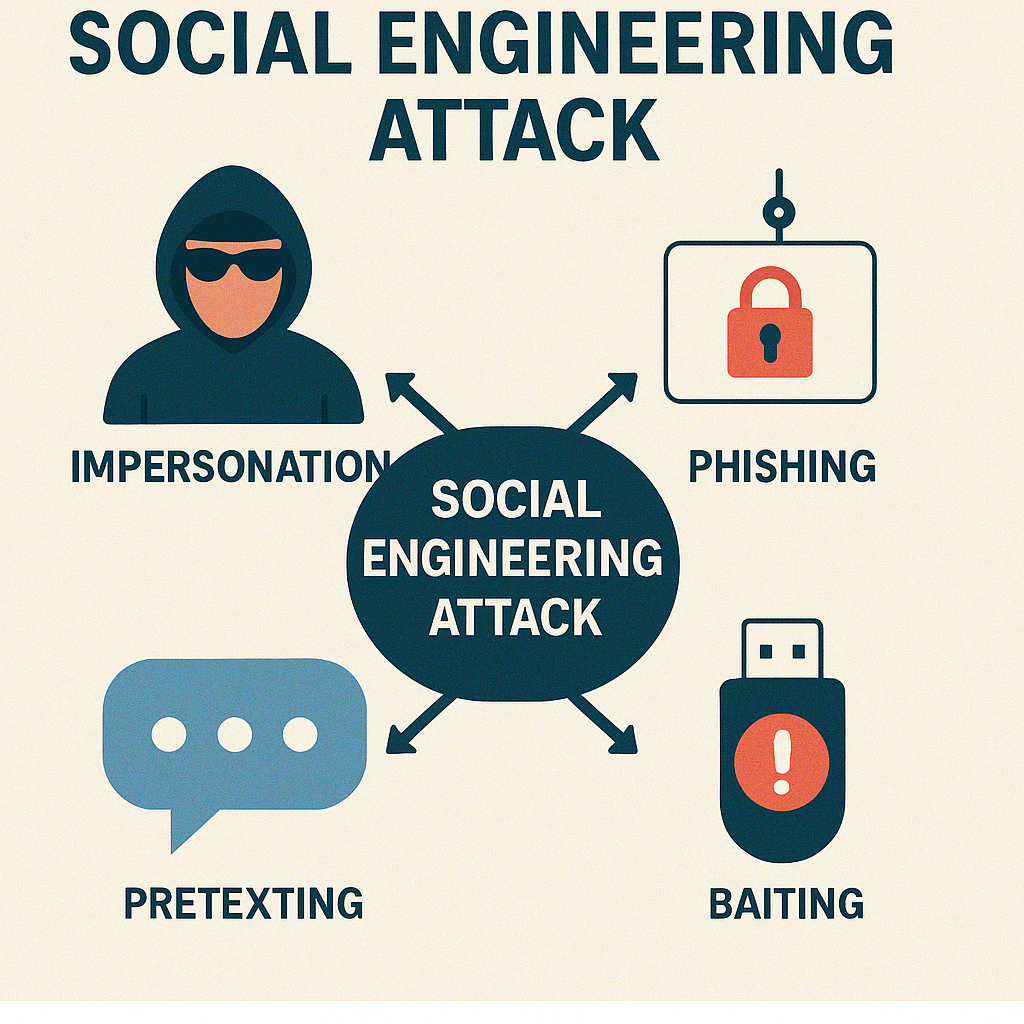🎯 The Human Is the Weakest Link — Learn How Hackers Exploit It
🚩 What Is Social Engineering?
Social engineering is the psychological manipulation of people to trick them into giving up confidential information, bypassing security measures, or performing actions that benefit the attacker.
In simple terms, hackers don’t always hack computers — they hack people.
Instead of exploiting software vulnerabilities, social engineers exploit human trust, fear, urgency, curiosity, and emotions.
⚠️ Disclaimer
This article is written for educational and ethical purposes only. Its goal is to help readers understand and defend against social engineering attacks.
🏴☠️ Why Social Engineering Works
Humans are predictable. We are wired to trust familiar faces, respond to authority, avoid conflict, and act quickly when pressured.
According to the Verizon 2023 Data Breach Investigations Report, 74% of breaches involve the human element, including social engineering, phishing, and errors.
FBI IC3 2023 confirms that business email compromise (BEC), a social engineering-based attack, caused over $2.9 billion in losses in a single year.
🔥 Common Social Engineering Techniques
1️⃣ Phishing
Fake emails, websites, or messages impersonating trusted sources.
✔️ Goal: Steal credentials, install malware, or trick victims into payments.
2️⃣ Vishing (Voice Phishing)
Phone calls impersonating banks, tech support, or government agencies.
✔️ Goal: Trick victims into revealing personal info or credentials.
3️⃣ Smishing (SMS Phishing)
Text messages with malicious links or fake alerts.
✔️ Goal: Drive victims to phishing websites or malware.
4️⃣ Pretexting
The attacker creates a fabricated scenario to gain the victim’s trust.
✔️ Example: Pretending to be from IT support requesting your password to “fix an issue.”
5️⃣ Baiting
Offering something tempting — free downloads, fake gifts, or USB drives labeled “Company Salaries” — to lure victims into installing malware.
6️⃣ Quid Pro Quo
Offering a service in exchange for information.
✔️ Example: Pretending to be tech support offering help in exchange for login credentials.
7️⃣ Tailgating (Piggybacking)
Physically following an authorized person into a restricted area.
✔️ Example: Holding a box and asking someone to hold the door open.
🏴☠️ Real-World Examples of Social Engineering
💣 Example 1: The Google and Facebook Scam
Between 2013 and 2015, a Lithuanian hacker tricked both Google and Facebook into wiring him over $100 million.
→ He sent fake invoices pretending to be from a real supplier.
→ The companies, trusting the context, paid without verifying.
💣 Example 2: Twitter Bitcoin Scam 2020
A group of attackers used social engineering to target Twitter employees.
→ They gained access to internal tools.
→ As a result, they hijacked high-profile accounts (Elon Musk, Apple, Jeff Bezos) to promote a Bitcoin scam.
→ Victims sent over $120,000 in Bitcoin within hours.
💣 Example 3: CEO Fraud (BEC)
A financial manager receives an urgent email from the “CEO” asking for an immediate wire transfer to close an urgent deal.
→ The manager complies, transferring hundreds of thousands of dollars — only to discover later the CEO never sent the email.
🎯 The Psychological Triggers Hackers Exploit
✔️ Authority:
→ “This is the CEO. Do this immediately.”
People tend to obey authority without questioning.
✔️ Urgency:
→ “If you don’t act now, the account will be closed.”
Creates pressure, reducing critical thinking.
✔️ Fear:
→ “Your computer is infected. Call us immediately.”
Victims panic and follow instructions.
✔️ Curiosity:
→ “Employee Bonuses 2024.xlsx” — attached malware.
People open it out of curiosity.
✔️ Reciprocity:
→ Offering fake help or gifts makes victims feel obligated to comply.
✔️ Trust:
→ Attackers impersonate colleagues, IT staff, or partners.
🔓 How Social Engineers Gather Information
🕵️ Open Source Intelligence (OSINT):
- LinkedIn, Facebook, Instagram
- Company websites
- Job postings
- Public records
✔️ They look for:
→ Names of employees, partners, suppliers
→ Org charts, email formats
→ Recent projects, upcoming events
→ Security gaps (e.g., phone numbers, outdated employees)
🛠️ How to Defend Against Social Engineering
🔐 Step 1: Zero Trust Mindset
→ Don’t trust, always verify.
→ Question unexpected emails, calls, or requests.
🔐 Step 2: Verify Requests Out of Band
→ If you get a wire transfer request via email, call the person directly using the official number — not the one in the email.
🔐 Step 3: Train Yourself and Your Team
→ Recognize psychological tricks.
→ Conduct regular phishing simulations and security training.
🔐 Step 4: Enable Technical Protections
→ Email filters, anti-phishing solutions.
→ DNS filtering, web protection tools.
→ Use 2FA or MFA everywhere.
🔐 Step 5: Lock Down Public Information
→ Audit what’s publicly visible online.
→ Remove unnecessary personal or company details from websites, LinkedIn, and social media.
🔐 Step 6: Secure Your Recovery Chains
→ Attackers often bypass 2FA by attacking account recovery processes.
→ Secure backup emails and phone numbers with 2FA.
🚫 Common Mistakes That Lead to Attacks
- ❌ Trusting caller ID (it can be spoofed).
- ❌ Clicking links in unsolicited messages.
- ❌ Assuming that internal-looking emails are safe.
- ❌ Sharing passwords with “IT” without verification.
- ❌ Ignoring warning signs like urgency or secrecy.

🚀 Checklist — Defend Against Social Engineering
- 🔲 Verify all unusual requests, especially financial.
- 🔲 Never share credentials over phone, email, or chat.
- 🔲 Use 2FA or MFA on all accounts.
- 🔲 Lock your SIM card against port-out attacks.
- 🔲 Check URL links carefully before clicking.
- 🔲 Disable auto-downloads for attachments and files.
- 🔲 Remove excessive personal/company info from public spaces.
- 🔲 Educate yourself and your team regularly.
🏆 Final Thoughts
Hackers don’t always rely on sophisticated malware. Instead, they often rely on manipulating human emotions.
They don’t break locks. They convince someone to open the door.
Understanding social engineering is no longer optional — it’s a mandatory part of digital self-defense in 2025 and beyond.
✅ Final Note
Sources referenced:
- Verizon Data Breach Investigations Report (DBIR) 2023
- FBI Internet Crime Complaint Center (IC3) 2023
- KrebsOnSecurity case studies
- Social-Engineer.org research
- CISA Social Engineering Defense Guidelines
